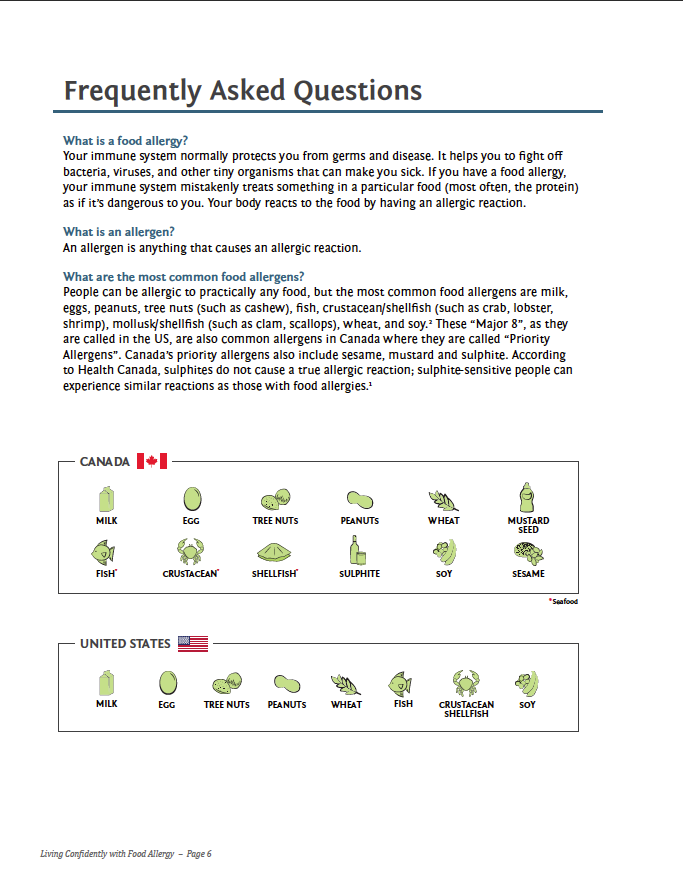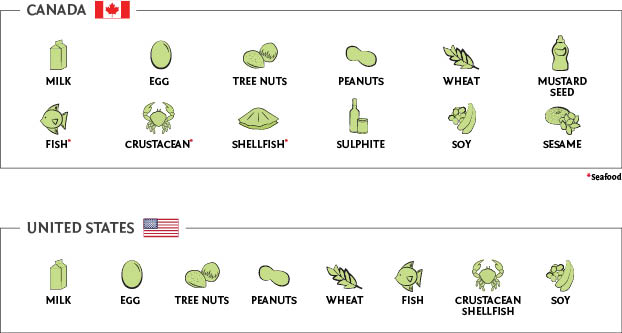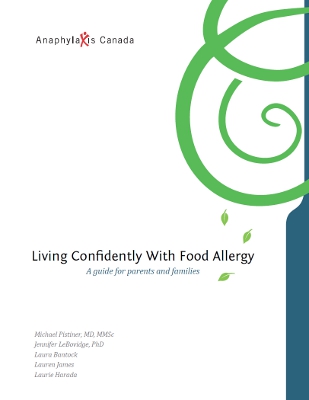 Frequently Asked Questions PDF
Frequently Asked Questions PDF
What is a food allergy?
Your immune system normally protects you from germs and disease. It helps you to fight off bacteria, viruses, and other tiny organisms that can make you sick. If you have a food allergy, your immune system mistakenly treats something in a particular food (most often, the protein) as if it’s dangerous to you. Your body reacts to the food by having an allergic reaction.
What is an allergen?
An allergen is anything that causes an allergic reaction.
What are the most common food allergens?
People can be allergic to practically any food, but the most common food allergens are milk, eggs, peanuts, tree nuts (such as cashew), fish, crustacean/shellfish (such as crab, lobster, shrimp), mollusk/shellfish (such as clam, scallops) , wheat, and soy2. These “Major 8”, as they are called in the US, are also common allergens in Canada where they are called “Priority Allergens”. Canada’s priority allergens also include sesame, mustard and sulphite. According to Health Canada, sulphites do not cause a true allergic reaction; sulphite-sensitive people can experience similar reactions as those with food allergies.

What are the common symptoms of an allergic reaction?
In the same person, each reaction can be different. Symptoms can include hives, itching, flushed skin, stomach pain, vomiting, diarrhea, hoarse voice, swelling of the lips, tongue, or throat, coughing, wheezing, sneezing, shortness of breath, irritability, confusion, sweating, dizziness, fainting, loss of consciousness and others.2 3
What is anaphylaxis?
Anaphylaxis is a severe life-threatening allergic reaction. At present, tests cannot tell us how severe a person’s reaction will be. It is also difficult for doctors to tell which patients are at risk for a severe reaction.2 3
How fast can a reaction to a food occur?
Most allergic reactions happen within minutes, but some can occur a few hours after exposure.2
How do you manage a food allergy?
People with food allergies must avoid coming into contact with foods that cause them to react (e.g. eating, touching). They must also be ready to treat an allergic reaction with emergency medication and get medical help.
What is cross-contamination (also known as cross-contact)?
These terms are used to describe the presence of an allergen that is transferred from one food or object to another. For example, cookies baked on the same tray as peanut butter cookies pose a risk of cross-contamination to someone with peanut allergy.
What is epinephrine?
Epinephrine (also known as adrenaline) is the medicine of choice used to treat a severe allergic reaction, anaphylaxis. It works quickly to reverse the symptoms of anaphylaxis, but in some cases, a second dose may be needed. The effects of epinephrine may only be temporary. 2 3 4
What is an epinephrine auto-injector?
This is a medical device used during an allergy emergency to give a measured dose of epinephrine into the thigh muscle.
What is an auto-injector training device?
This looks like a real auto-injector but does not have a needle or medication in it. It is used for practice and to show people how to use the real auto-injector in an emergency.
What is an Anaphylaxis Emergency Plan?
There are different names for written allergy plans, such as Emergency Care Plan and Food Allergy Action Plan. The plan is generally a one page document that gives detailed information about your child’s food allergies. It also includes important information on symptoms, how to treat a reaction and how to get emergency help.
2. National Institute of Allergy and Infectious Disease (NIAID)-Sponsored Expert Panel. “Guidelines for the Diagnosis and Management of Food Allergy in the United States: Report of the NIAID-Sponsored Expert Panel.” The Journal of Allergy and Clinical Immunology 126.6 (2010): S1-S58.
3. Sampson, H.A. et. al. “Second symposium on the definition and management of anaphylaxis: Summary report—Second National Institute of Allergy and Infectious Disease/Food Allergy and Anaphylaxis Network symposium.” The Journal of Allergy and Clinical Immunology 117.2 (2006): 391-397.
4. Canadian Society of Allergy and Clinical Immunology. Anaphylaxis in School & Other Settings. 2nd Ed. Revised. 2011.
